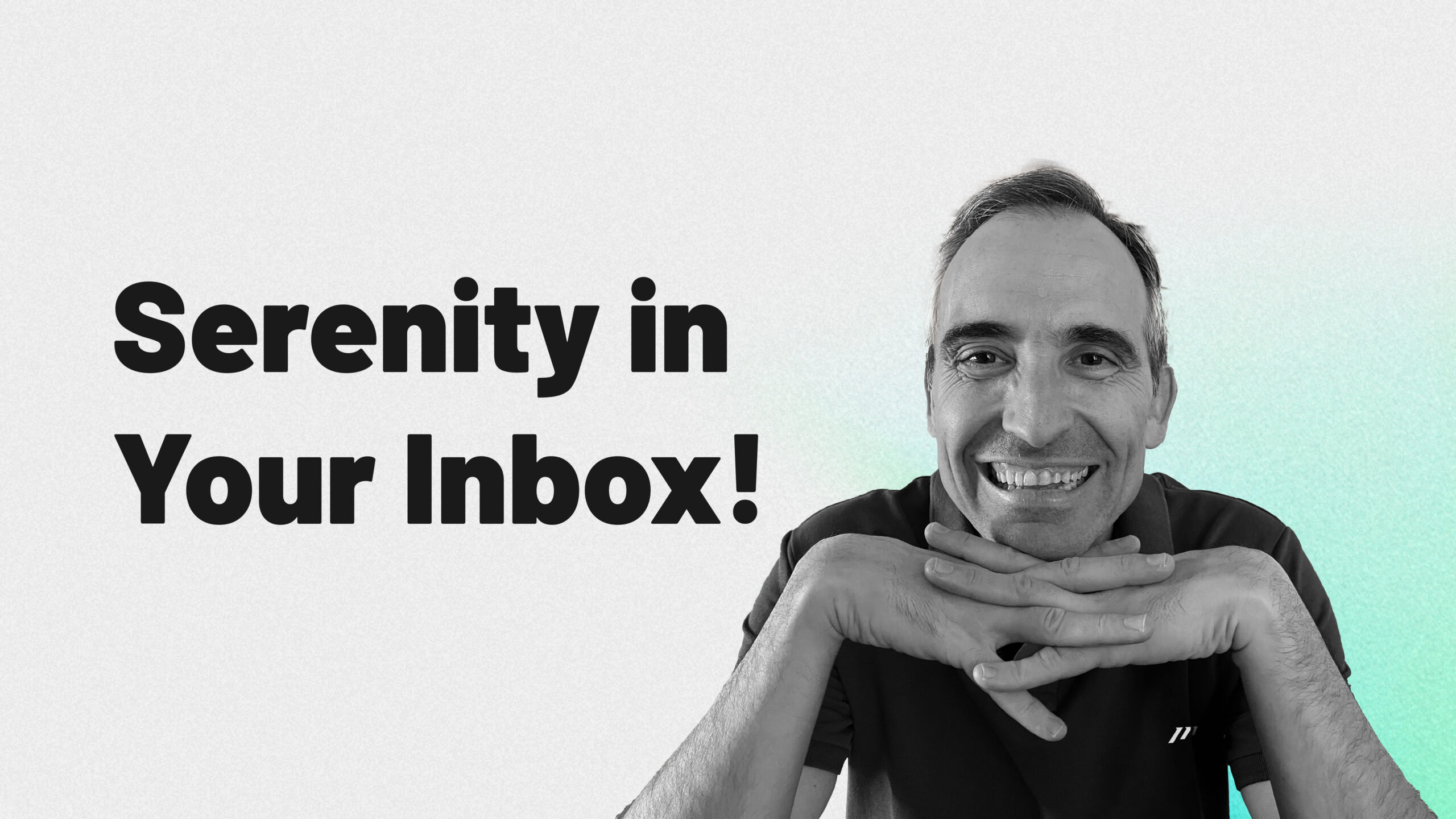Email has been around since the dawn of the internet and, despite countless attacks (including many from me), it remains an essential tool for business professionals. As an incredible asynchronous communication method, it offers unparalleled benefits.
Inside the ICOR® Framework, email sits at the intersection of Personal Project Management (PPM), Personal Knowledge Management (PKM), and Business Knowledge Management (BKM), so you can imagine how crucial it is to my daily work life!
No messaging tool can truly compete, especially when working with mid-size teams (60 people in my case) and engaging with thousands of people externally (clients, suppliers, and anything in between).
Admittedly, I’ve reduced my internal email traffic thanks to project management and messaging tools for specific workflows. Still, email remains a vital tool I couldn’t live without.
Years ago, I made the decision to turn email from enemy to ally. This was the smartest move, considering I couldn’t defeat it.
Managing four businesses simultaneously and a busy personal life, I receive hundreds of emails daily, making it challenging to develop and implement a streamlined workflow.
However, I conquered this challenge years ago and no longer struggle with email management.
If you’re a business professional facing similar issues and seeking inspiration, solutions, or that “aha” moment to transform your email management, this article is for you.
Let’s dive in!
Superhuman Empowers Performance and Transforms Your Email Game
While I already had a similar workflow on Gmail, it was Superhuman that truly optimized my process and unlocked its full potential.
It’s not accurate to think of Superhuman as just a pricey version of Gmail’s free services.
Although it’s not essential for implementing the workflow I’ll describe, I highly recommend it if you manage multiple email accounts and deal with hundreds of emails daily.
Superhuman especially beneficial for those in C-level positions or higher, where effectively managing your team and ensuring peak performance is crucial.
I’ll explain everything using Superhuman to showcase its power and make it easier for you to grasp the concepts and workflows I’ll discuss. Yet, you can implement these workflows in many other email clients.
The team behind Superhuman understands that email management is a task in itself, requiring dedicated focus and a workflow you can execute on autopilot.
This is why I’m passionate about designing and creating systems. Once you have a system in place, you just need a tool to implement it.
For email management, Superhuman is that tool.
5 Essential Concepts for Unprecedented Progress
Before moving forward, I’d like to highlight some key aspects:
1. The “Inbox 0” Concept
Inbox 0 means you’ve completed all necessary actions at this moment. I mean, NOW.
It doesn’t mean you’ve finished all tasks generated by an email.
You can achieve Inbox 0 even with unfinished tasks, and this is where Superhuman excels.
It goes beyond email management by becoming a specialized task management tool for emails.
2. Don’t Clutter Your Task Management Tools
Some people suggest creating a task in your task manager for each email-generated task.
I disagree, as it can clutter your task manager.
You have enough Output Elements, using ICOR® terminology, in your task manager to even toss more elements inside.
Superhuman’s approach keeps most email-generated tasks within its platform, preventing clutter.
Later on, I’ll tell you the only exception I consider.
3. Block Time for Email Management
It’s important to recognize that email management is a highly specific task with well-defined workflows you can execute on autopilot, engaging both the physical and digital aspects of your brain.
That’s right, there’s no need for a second brain; you have just one brain that uses the same workflows, whether it’s through your neurons or a digital tool.
This seamless integration allows you to perform at peak levels, with zero friction and laser-like focus.
Given the clear structure of email management, it’s an ideal task for allocating dedicated time blocks, allowing you to fully immerse yourself and block out distractions.
Personally, I schedule two email management blocks every day to maintain optimal efficiency.
4. Inside and Outside an Email
In Superhuman, you have the flexibility to manage your emails either from within an email (inside) or from your inbox (outside).
This feature allows you to seamlessly navigate through your emails without having to constantly return to your inbox, streamlining your email management process.
While some email clients offer a similar function, the focus of this article is to highlight Superhuman’s capabilities to better understand the workflows and concepts I describe. Just that.
If your current email client supports this feature, great!
If not, consider adopting some of the strategies discussed here to enhance your email management experience.
And if all else fails, Superhuman may be the solution you’re looking for.
Ultimately, understanding and utilizing the “inside” and “outside” concept is key to efficient email management.
5. The “Done” Machine
In Superhuman, marking an email as done automatically displays the next email in your inbox staying “inside”.
This allows you to quickly take the appropriate action on the email you’re currently viewing.
In the following section, I’ll detail the various actions you can perform.
This is the method I use to efficiently navigate through my emails (inside).
How to Master Email Processing
Well, let’s go to the meat!
When I open my first email, I consider the appropriate action to take.
There are only two options:
- If the email only requires reading or a quick action that takes less than 2 minutes (based on the GTD principle), I can simply read it or take the action (such as a brief reply or forwarding), and mark it as done. This removes the email from my inbox. Rest assured, it’s not deleted from the system and can still be searched for, but it won’t clutter my inbox unless I intentionally mark it as “undone.”
- If the email demands a more time-consuming action (taking over 2 minutes), it initiates a new workflow, which I’ll discuss in the next section.
Remember, after completing the action, Superhuman automatically presents the next email for you to process.
How to Handle “Complex” Action Emails
As “complex” I refer to “more-than-2-minute” actions.
This is where the challenge and trouble arise.
It’s the situation where email management faces task management.
That’s why to address this, I’ve dedicated this specific section in the article to handling such scenarios.
The primary rule is: only forward an email to your task manager if it represents a vital task for you.
By vital, I mean highly important or a task that requires over 30 minutes of your time (this is a rough estimate to help you identify these types of emails).
For instance, I recently prepared extensive documentation for a significant loan for one of my companies.
This process was both time-consuming and crucial, so I sent the email to my task manager, Sunsama.
This allowed me to keep the task organized within my micro-management system, and easily access the email when needed.
So, what should you do with emails that don’t make it to your task manager?
Keep them in Superhuman and manage them within the tool itself.
Let’s explore how to do that!
How to Manage “Task Emails” inside Superhuman
The “Snooze” feature truly excels in this context.
Consider the situation we’re dealing with:
- The email requires an action.
- The action takes more than 30 minutes.
When assessing the email, ask yourself: When do I want to complete this task?
Keep in mind, it’s no longer just an email; it’s a task or as we name it in ICOR®: a TO-DO.
Shift your thinking towards task management workflows:
- If you plan to tackle it today, leave it in your inbox.
- If not, snooze it to a specific time or date. The email will disappear and only reappear in your inbox at the designated time.
Let’s examine an example to highlight the effectiveness of this workflow.
Suppose you need to forward an email to someone and await their response to continue your task. Here are the steps to follow:
- Forward the email to the recipient.
- Snooze it for the desired follow-up time or date.
The advantages are:
- If the recipient replies before the snooze period ends, the email reappears in your inbox.
- If not, the email returns to your inbox at the snoozed time/date, prompting you to follow up.
That’s how people will ask you, “I don’t understand how the hell you never forget about something you sent to me…”.
Isn’t that powerful?
Imagine following a workflow where you send all “task emails” to your task manager:
- You create the task in your task manager.
- You switch to your email client and forward the email to the recipient.
- You update the task status in your task manager to “waiting.”
- You add comments for context, like “sent follow up at…”.
- At some point, you review your “waiting” tasks, return to the email, and follow up.
- You update the task in your task manager.
- When you receive a reply, you revisit your task manager to change the task status.
This constant back-and-forth between email and task management tools creates friction and frustration, making it feel like you’re trapped in an endless cycle, a black hole, an endless nightmare that even gets worse when you add “volume” (BIG volume) to the equation.
With the suggested workflow, your inbox only contains emails (tasks) you plan to address today, while the rest are done or snoozed.
It’s a moment of clarity.
During your designated email management time block, it’s the time you also use to tackle those TO-DOs (“task emails”).
As you can see, your email management time block serves two purposes:
- Streamlining your inbox by reading, executing quick actions, or snoozing emails, which brings clarity.
- Completing the TO-DOs for emails you’ve committed to addressing today.
A Last Useful Hack
At the Paperless Movement®, we’re passionate about creating systems, defining workflows, and implementing them effectively.
That’s the strength of reliable concepts, workflows, and systems.
Once you understand a concept, you can apply it universally because it becomes deeply ingrained in your mind and core.
We often discuss micro-management and macro-management, which represent various aspects.
In the world of action, for example, they differentiate between:
- Personal Project Management (PPM).
- Business Project Management (BPM).
PPM corresponds to the “task management world”, mainly involving tasks and TO-DOs, while BPM represents the “project management world”, focusing on goals and projects.
Each approach enables you to zoom in or out, adjusting your perspective from a detailed view to a broader bird’s-eye view for a complete picture.
You can apply these micro-management and macro-management concepts to email management using the “inside and outside” concept I mentioned earlier.
When you’re inside an email, you’re in the micro-management realm, focusing solely on that email and deciding what action to take.
When you’re outside an email, you gain a broader view of your inbox.
One of Superhuman’s key features is the ability to perform bulk actions.
For instance, when viewing your inbox from the outside, you can quickly select multiple emails and execute a single action for all of them.
Imagine reaching the end of your email management time block, with no time left (anxiety) and some emails still pending (more anxiety).
Using the outside perspective, you can select all remaining emails and snooze them collectively until your next email management time block.
BOOM (release): inbox 0!
Remember, time is finite, and so are your resources.
Being in a limited world means working within constraints.
Time isn’t infinite.
Make the most of what you have.
Takeaways
Transition your email management approach to a task management mindset.
Allocate the appropriate time for email management, based on your role and the importance of emails in your work.
Establish fixed time blocks for email management, and set aside other TO-DOs during those periods.
I’ve been following this method for decades. It simply works.




